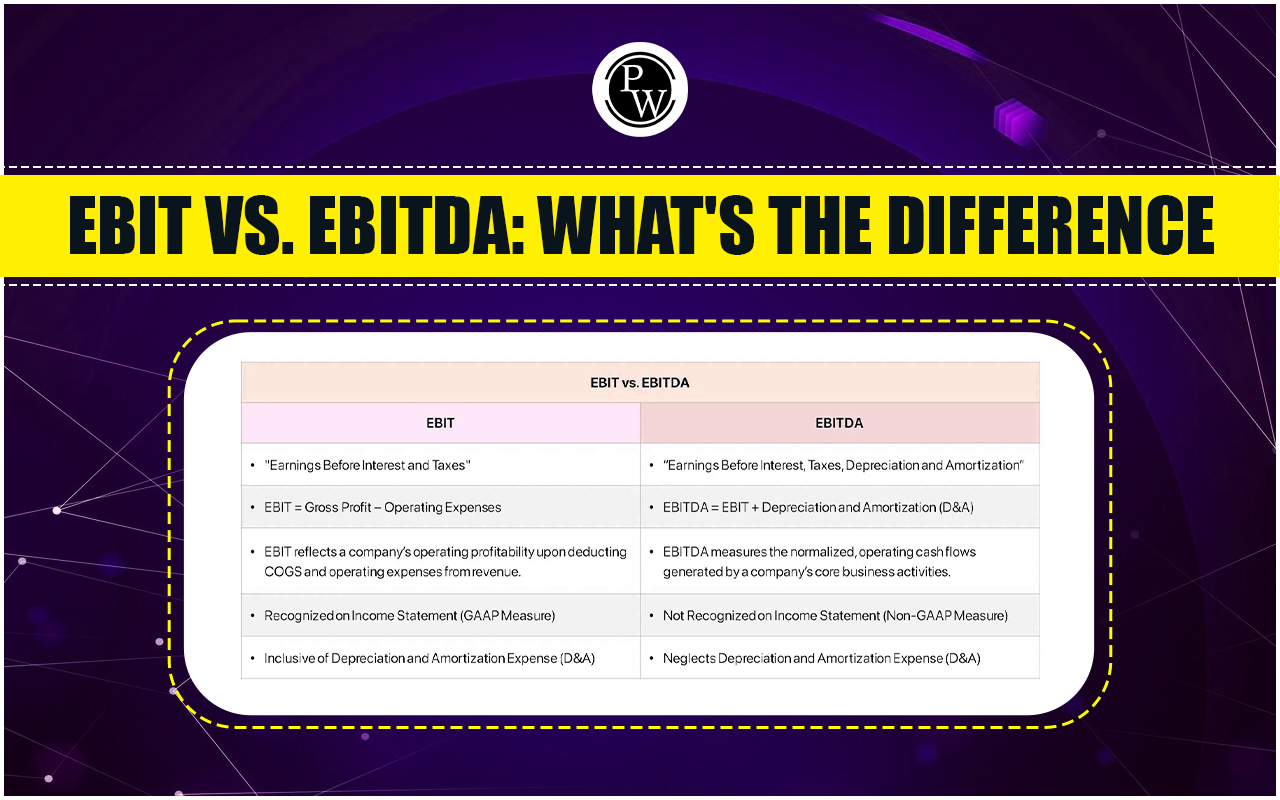

EBIT Vs EBITDA: What are EBIT and EBITDA, and why are they important in understanding a company's profitability? For commerce students , knowing the differences between these two metrics is essential. EBIT (Earnings Before Interest and Taxes) and EBITDA (Earnings Before Interest, Taxes, Depreciation , and Amortization) are both used to measure a company's financial performance.
While EBIT focuses on a company's ability to generate profit from its operations by excluding interest and taxes, EBITDA goes a step further by also excluding depreciation and amortization. Understanding EBIT Vs EBITDA helps students analyze how these differences impact the assessment of a company's financial health. Here, we will explore everything about EBIT Vs EBITDA, including their definitions, key differences, how to calculate them, and examples to help clarify these concepts.What is EBIT?
EBIT, or Earnings Before Interest and Taxes, is a metric indicating a company's operating profitability. It shows the profit generated from a company's core operations, excluding expenses related to interest on debt and taxes. This makes EBIT a useful metric for assessing how well a business is performing in its main activities without being influenced by its financial structure or tax obligations. The information to calculate EBIT is found on the income statement, which details a company’s revenues and expenses over a specific period. While some businesses track this data using spreadsheets, accounting software is often a more efficient and accurate solution, especially as the company grows. Such software can also integrate with other systems like payroll and inventory management, simplifying overall financial management.How to Calculate EBIT?
When comparing EBIT vs. EBITDA, it's important to understand how to calculate EBIT. There are two methods to accomplish this. The first method involves starting with the company’s net income and then adding back any interest expenses and taxes. This formula looks like this:- EBIT = Net income + Interest expenses + Taxes
- EBIT = Sales revenue - COGS - Operating expenses
What is EBITDA?
EBITDA, or Earnings Before Interest, Taxes, Depreciation and Amortization , is a key measure of a company's financial performance. It focuses on the profitability of a company's core operations by excluding the effects of capital expenditures, interest, and taxes. This makes EBITDA a useful tool for comparing companies within the same industry, as it only considers cash-related expenses. Unlike EBIT, EBITDA removes non-cash expenses like depreciation and amortization, which are methods of spreading the cost of assets over time. By excluding these, EBITDA provides a clearer view of a company’s operational profitability without being influenced by its capital structure or tax situation. However, it's important to remember that EBITDA does not account for changes in working capital, so it isn’t the same as operating cash flow.How to Calculate EBITDA?
When comparing EBIT vs EBITDA, knowing how to calculate EBITDA is essential. There are two common methods to do this. The first method starts with net income and adds back interest, taxes, depreciation, and amortization. The formula looks like this:- EBITDA = Net income + Interest expense + Taxes + Depreciation + Amortization
- EBITDA = EBIT + Depreciation + Amortization
What is the Difference Between EBIT and EBITDA?
Understanding the differences between EBIT and EBITDA is crucial for evaluating a company's financial performance. Both metrics are used to assess profitability, but they offer distinct insights into how a company operates and manages its finances. Here's a comparison of EBIT Vs EBITDA, highlighting their key features and differences:| EBIT Vs EBITDA: Key Differences | ||
| Aspects | EBIT | EBITDA |
| Meaning | Earnings Before Interest and Taxes: Profit from operations before interest and tax expenses | Earnings Before Interest, Taxes, Depreciation, and Amortization: Profit from operations before interest, taxes, depreciation, and amortization |
| Focus | Measures profit from operations; often similar to operating income | Focuses on cash profitability from operations |
| Exclusions | Excludes interest and taxes | Excludes interest, taxes, depreciation, and amortization |
| Used by | Widely reported, especially by companies with high debt and strong operational performance | Preferred for companies with significant investments in fixed assets and high levels of debt |
| Non-Cash Charges | Includes non-cash charges (depreciation and amortization) | Does not include non-cash charges |
| Potential Misleading Aspect | Can give a misleading impression of a company’s resilience to falling sales | Can give a misleading impression of the business’s overall financial health |
| Why Calculate Them | Provides insight into operating income and profitability | Offers a clearer view of cash profitability, useful for comparing companies with different asset structures |
| Impact of Capital Structure | Affected by capital structure; includes interest expenses | Not affected by capital structure; excludes interest |
Also Check: Difference Between the Balance Sheet and the Cash Flow Statement
EBIT Vs EBITDA Example
To illustrate the difference between EBIT and EBITDA, let’s look at an example using a hypothetical company with the following financial details:| Income Statement | |
| Item | Amount (INR) |
| Sales Revenue | ₹1,200,000 |
| Cost of Goods Sold (COGS) | ₹800,000 |
| Operating Expenses | ₹120,000 |
| Interest Expense | ₹70,000 |
| Tax Paid | ₹50,000 |
| Net Income | ₹160,000 |
| Cash Flow Statement | |
| Item | Amount (INR) |
| Net Income | ₹160,000 |
| Less: Depreciation & Amortization | ₹70,000 |
| Less: Changes in Working Capital | ₹10,000 |
| Cash from Operations | ₹80,000 |
Calculating EBIT:
From Net Income: EBIT = Net Income + Tax Paid + Interest Expense EBIT = ₹1,60,000 + ₹50,000 + ₹70,000 EBIT = ₹2,80,000 From Revenue: EBIT = Sales Revenue - COGS - Operating Expenses EBIT = ₹12,00,000 - ₹8,00,000 - ₹1,20,000 EBIT = ₹2,80,000Calculating EBITDA:
EBITDA = EBIT + Depreciation and Amortization EBITDA = ₹2,80,000 + ₹70,000 EBITDA = ₹3,50,000 In this example, EBITDA is higher than EBIT. This suggests that the company might prefer to highlight EBITDA to emphasize its cash profitability, given its high depreciation and interest expenses.Also Check: Consumption, Definition, Importance, and Economic Impact
Moreover, understanding the distinction between EBIT Vs EBITDA is crucial for analyzing a company's financial performance. EBIT focuses on a company's core profitability by excluding interest and taxes, while EBITDA provides a clearer view of cash flow by also excluding non-cash expenses like depreciation and amortization. Both metrics offer valuable insights, but they cater to different aspects of financial analysis. For commerce students looking to deepen their understanding of financial metrics, Physics Wallah (PW) offers the best coaching. Recognized for its excellence in preparing students for competitive exams and detailed financial concepts, PW provides comprehensive guidance that helps students excel in their studies and future careers in commerce. Ready to master financial concepts and excel in commerce? Join now and sign up for the PW Commerce Online Course to get expert guidance and succeed in your exams!| Also Check: | |
| Balance Sheet | Monopoly |
| Speculation | Network Marketing |
| Maslow’s Hierarchy of Needs | Development Of Indian Accounting Standards |
EBIT Vs EBITDA FAQs
What is the difference between EBIT and EBITDA?
EBIT (Earnings Before Interest and Taxes) focuses on operating income by excluding interest and taxes. EBITDA (Earnings Before Interest, Taxes, Depreciation, and Amortization) goes further by also excluding non-cash expenses like depreciation and amortization, providing a clearer view of cash profitability.
How is EBIT calculated?
EBIT is calculated by adding interest and taxes back to net income. The formula is EBIT = Net Income + Interest + Taxes. This calculation gives a picture of a company's operating profit before considering interest and tax expenses.
How is EBITDA calculated?
EBITDA is calculated by adding depreciation and amortization to EBIT. The formula is EBITDA = EBIT + Depreciation + Amortization. This calculation removes non-cash expenses, giving a clearer view of the company's cash profitability.
Why is EBIT considered more reliable than EBITDA?
EBIT is considered more reliable than EBITDA because it includes depreciation and amortization, which are real expenses that affect a company's profitability. This makes EBIT a more conservative and accurate measure of financial performance.
When should you use EBITDA over EBIT?
EBITDA is often used when comparing companies with different asset structures or when focusing on cash flow, as it excludes non-cash expenses. It is especially useful for companies with significant investments in assets that are depreciating.
Talk to a counsellorHave doubts? Our support team will be happy to assist you!

Check out these Related Articles
Free Learning Resources
PW Books
Notes (Class 10-12)
PW Study Materials
Notes (Class 6-9)
Ncert Solutions
Govt Exams
Class 6th to 12th Online Courses
Govt Job Exams Courses
UPSC Coaching
Defence Exam Coaching
Gate Exam Coaching
Other Exams
Know about Physics Wallah
Physics Wallah is an Indian edtech platform that provides accessible & comprehensive learning experiences to students from Class 6th to postgraduate level. We also provide extensive NCERT solutions, sample paper, NEET, JEE Mains, BITSAT previous year papers & more such resources to students. Physics Wallah also caters to over 3.5 million registered students and over 78 lakh+ Youtube subscribers with 4.8 rating on its app.
We Stand Out because
We provide students with intensive courses with India’s qualified & experienced faculties & mentors. PW strives to make the learning experience comprehensive and accessible for students of all sections of society. We believe in empowering every single student who couldn't dream of a good career in engineering and medical field earlier.
Our Key Focus Areas
Physics Wallah's main focus is to make the learning experience as economical as possible for all students. With our affordable courses like Lakshya, Udaan and Arjuna and many others, we have been able to provide a platform for lakhs of aspirants. From providing Chemistry, Maths, Physics formula to giving e-books of eminent authors like RD Sharma, RS Aggarwal and Lakhmir Singh, PW focuses on every single student's need for preparation.
What Makes Us Different
Physics Wallah strives to develop a comprehensive pedagogical structure for students, where they get a state-of-the-art learning experience with study material and resources. Apart from catering students preparing for JEE Mains and NEET, PW also provides study material for each state board like Uttar Pradesh, Bihar, and others
Copyright © 2025 Physicswallah Limited All rights reserved.
Get App











